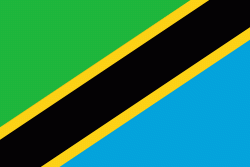Dodoma Region (Dodoma Region)
Dodoma's name derives from the Gogo word, Idodomya, the location of an elephant's sinking.
The city of Dodoma where the region gets its name, is the largest city and capital of the region, originally began as a small Gogo village in the early 19th century, consisting of several traditional tembe houses. The city was formally established in 1907 by German colonists during construction of the Tanzanian central railway. The region has a long history of famine and economic difficulties. Along with Kondoa and Singida it was struck hard by the famine of the 1910s. One report by a British officer in Dodoma in December 1916 reported that "The whole District has been ransacked for cattle". The Germans had killed 26,000 animals, and the British 5,659. The problems continued throughout 1917, and in November 1917 drought turned it into a crisis. Some 30,000, about 1 in 5 of the population of the district at the time died. Thousands of people emigrated, and others sold starving cattle for just a shilling at the market in Dodoma. Smallpox was prevalent, and a Spanish influenza epidemic killed an estimated 50,000–80,000 in Tanganyika between 1918 and 1920.
When the British took over the country, they favoured Dar es Salaam and Arusha, and the area began to decline in importance. The importance declined further in the 1960s when the Tanzam Highway was built by the Chinese, connecting Dar es Salaam to Morogoro and Iringa. On 9 December 1961, Tanganyika won independence from Britain, and Dodoma remained the capital of the Central Province. In 1963, the provinces of the new nation were divided into smaller administrative units and were renamed regions, and the Dodoma Region was established. However, in 1973, the Tanzanian government announced that the capital would be moved from Dar es Salaam to a more central location to better serve the needs of the people. Dodoma was selected for this purpose, as it was an already established town at a major crossroads with an agreeable climate and scope for development. The same year, the Tanzanian government launched a national soil conservation programme, known as the Dodoma Soil Conservation Programme, to improve soil fertility and productivity in the worst affected areas of the region.
Map - Dodoma Region (Dodoma Region)
Map
Country - Tanzania
 |
 |
| Flag of Tanzania | |
Many important hominid fossils have been found in Tanzania, such as 6-million-year-old Pliocene hominid fossils. The genus Australopithecus ranged across Africa between 4 and 2 million years ago, and the oldest remains of the genus Homo are found near Lake Olduvai. Following the rise of Homo erectus 1.8 million years ago, humanity spread all over the Old World, and later in the New World and Australia under the species Homo sapiens. H. sapiens also overtook Africa and absorbed the older species of humanity. Later in the Stone and Bronze Age, prehistoric migrations into Tanzania included Southern Cushitic speakers who moved south from present-day Ethiopia; Eastern Cushitic people who moved into Tanzania from north of Lake Turkana about 2,000 and 4,000 years ago; and the Southern Nilotes, including the Datoog, who originated from the present-day South Sudan–Ethiopia border region between 2,900 and 2,400 years ago. These movements took place at about the same time as the settlement of the Mashariki Bantu from West Africa in the Lake Victoria and Lake Tanganyika areas. They subsequently migrated across the rest of Tanzania between 2,300 and 1,700 years ago.
Currency / Language
| ISO | Currency | Symbol | Significant figures |
|---|---|---|---|
| TZS | Tanzanian shilling | Sh | 2 |
| ISO | Language |
|---|---|
| AR | Arabic language |
| EN | English language |















